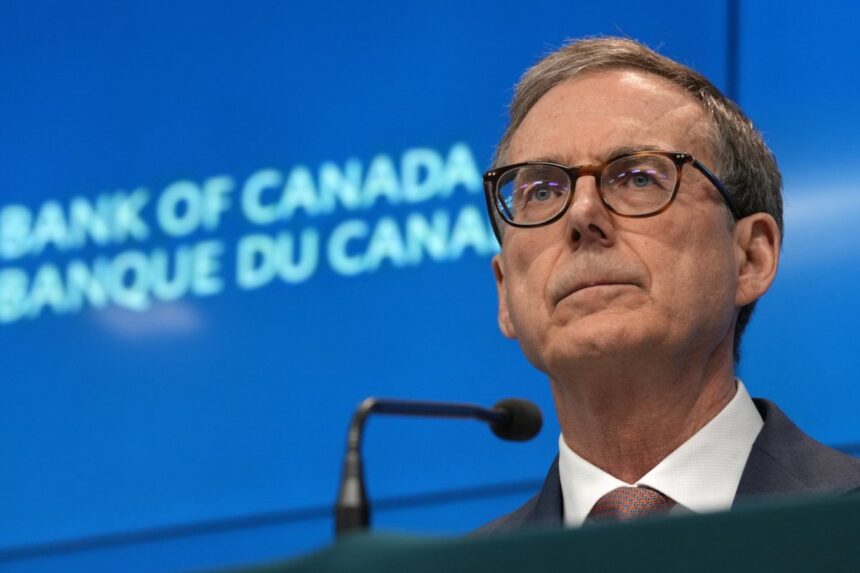The morning frost still clung to Ottawa’s downtown core as Bank of Canada governor Tiff Macklem stepped to the podium last week, his measured tone belying the complexity of Canada’s current economic landscape. After holding the key interest rate steady at 4.5% for the third consecutive time, Macklem’s cautious optimism about inflation’s downward trajectory came with significant caveats that investors and everyday Canadians alike should heed.
“We’re seeing encouraging signs, but the battle against inflation isn’t over,” Macklem stated, referencing April’s consumer price index dropping to 3.3%, down from March’s 4.3%. “Core inflation remains elevated, and we need further evidence before making any decisive moves.”
The Bank’s hesitancy stems from a complicated inflation picture that lacks clarity in several crucial areas. While headline inflation has cooled, underlying price pressures remain stubbornly persistent. The data shows diverging trends: goods inflation has moderated significantly, but service inflation continues to run hot at approximately 4.5%.
TD Bank senior economist James Orlando explained the dilemma facing policymakers: “The Bank is caught between conflicting indicators. Supply chains have normalized, bringing down goods prices, but domestic service inflation driven by wage growth and housing costs remains elevated.”
Housing costs represent a particular challenge. Despite higher interest rates cooling the real estate market temporarily, recent months have shown renewed price acceleration in major markets. Vancouver and Toronto have recorded month-over-month price increases exceeding 3% in some segments, suggesting the housing component of inflation may resist the central bank’s efforts.
The labour market presents another puzzle piece that doesn’t quite fit the traditional economic model. Despite six consecutive interest rate hikes, unemployment remains near historic lows at 5.2%. This tight labour market continues to drive wage growth above 4% annually, potentially feeding into service inflation.
“What makes this cycle unique is the resilience of employment despite aggressive monetary tightening,” noted Desjardins economist Royce Mendes. “The Bank expected higher rates to cool labour demand more significantly by now.”
Global factors further complicate Canada’s inflation outlook. While energy prices have moderated from their 2022 peaks, geopolitical tensions threaten new supply disruptions. Meanwhile, climate-related agricultural challenges have kept food inflation elevated at 7.4% year-over-year, significantly above the overall CPI.
The central bank’s quarterly Monetary Policy Report highlighted another concern: inflation expectations remain “sticky” among businesses and consumers. Survey data indicates many Canadians still expect inflation to run above 3% through 2024, potentially creating a self-fulfilling prophecy as workers seek higher wages and businesses raise prices in anticipation.
For Canadian households navigating this uncertainty, the implications are significant. The average variable-rate mortgage holder has seen their payments increase by approximately 45% since early 2022. According to Statistics Canada, the debt service ratio for Canadian households hit 15.2% in Q1 2023, approaching record levels.
“We’re approaching a crucial period where the cumulative impact of rate hikes will fully materialize through the economy,” warned RBC assistant chief economist Nathan Janzen. “Approximately 50% of fixed-rate mortgages will renew at significantly higher rates over the next 18 months.“
The Bank of Canada now finds itself walking a tightrope – keeping rates restrictive enough to tame inflation without triggering a severe economic downturn. Financial markets are currently pricing in a potential rate cut by October, but Macklem has pushed back against such expectations, emphasizing the need for clearer evidence of sustainable progress toward the 2% target.
For now, Canadians should prepare for a prolonged period of elevated interest rates. Financial advisors recommend stress-testing household budgets against potentially higher borrowing costs through 2024, while businesses may need to reassess expansion plans that depend on cheaper financing.
As the summer approaches, all eyes will be on the June inflation report for clearer signals on whether the Bank’s current stance is sufficient. Until then, uncertainty remains the only certainty in Canada’s complex economic picture.
For more financial insights and analysis, visit CO24 Business for our latest coverage on economic trends affecting Canadians.










